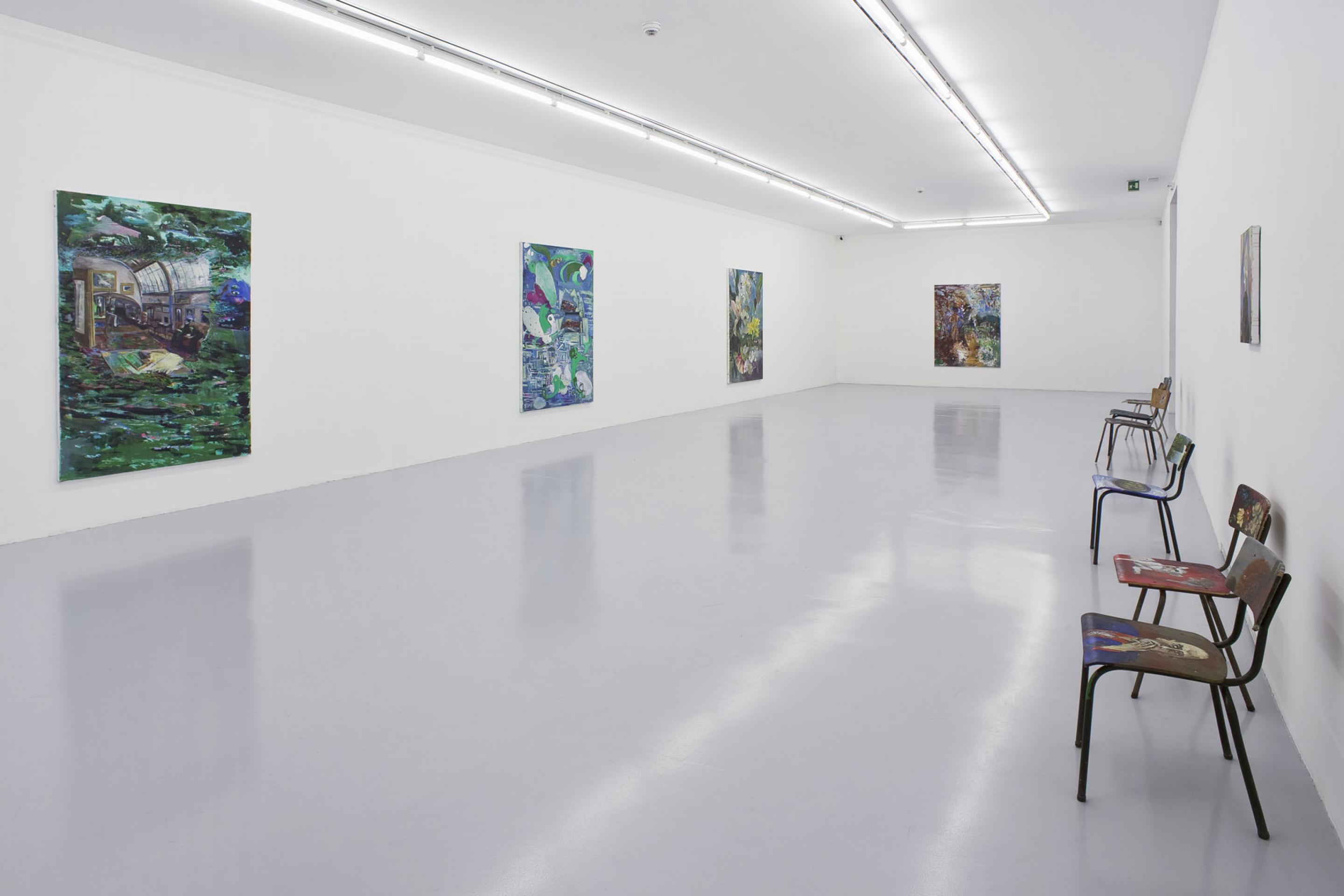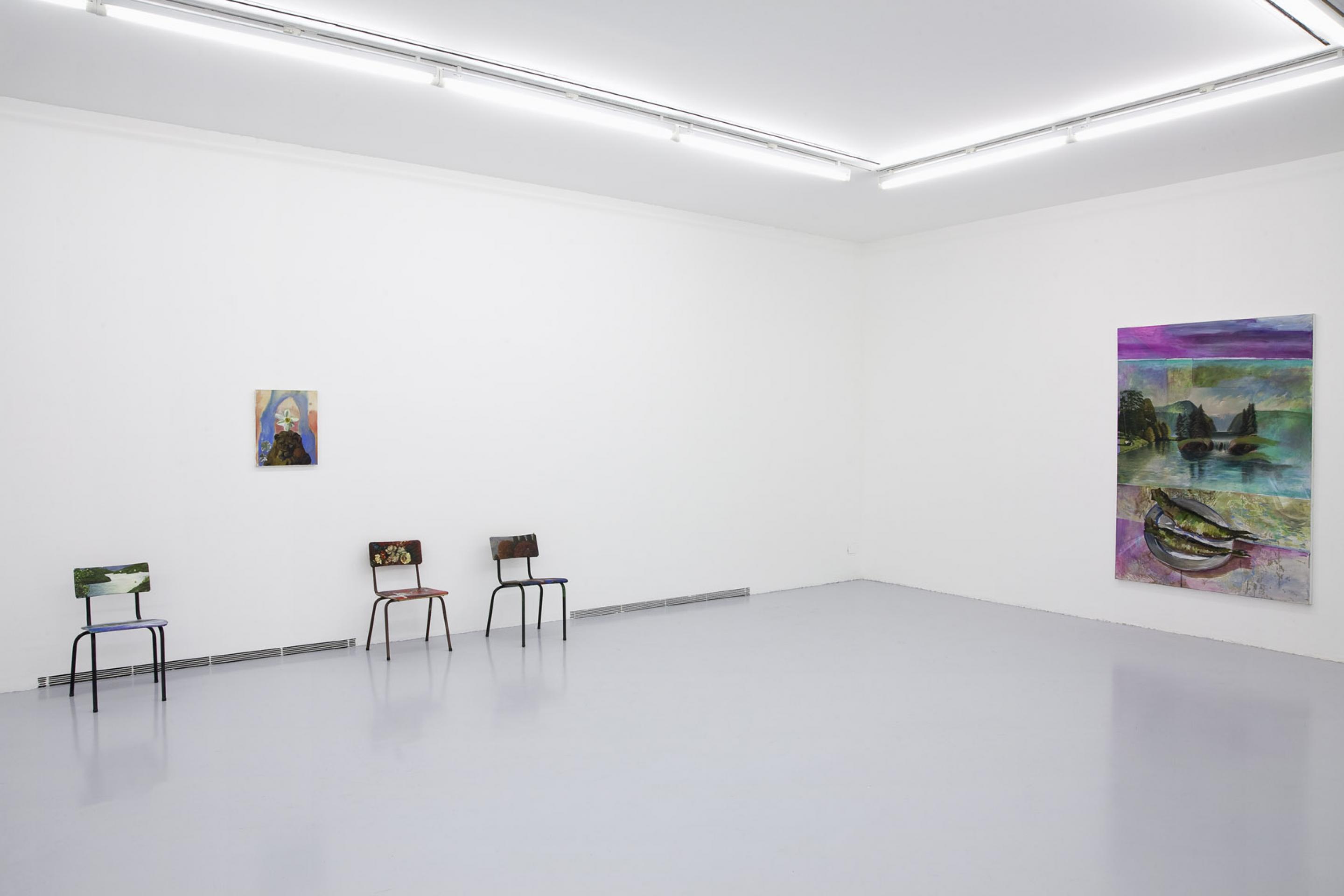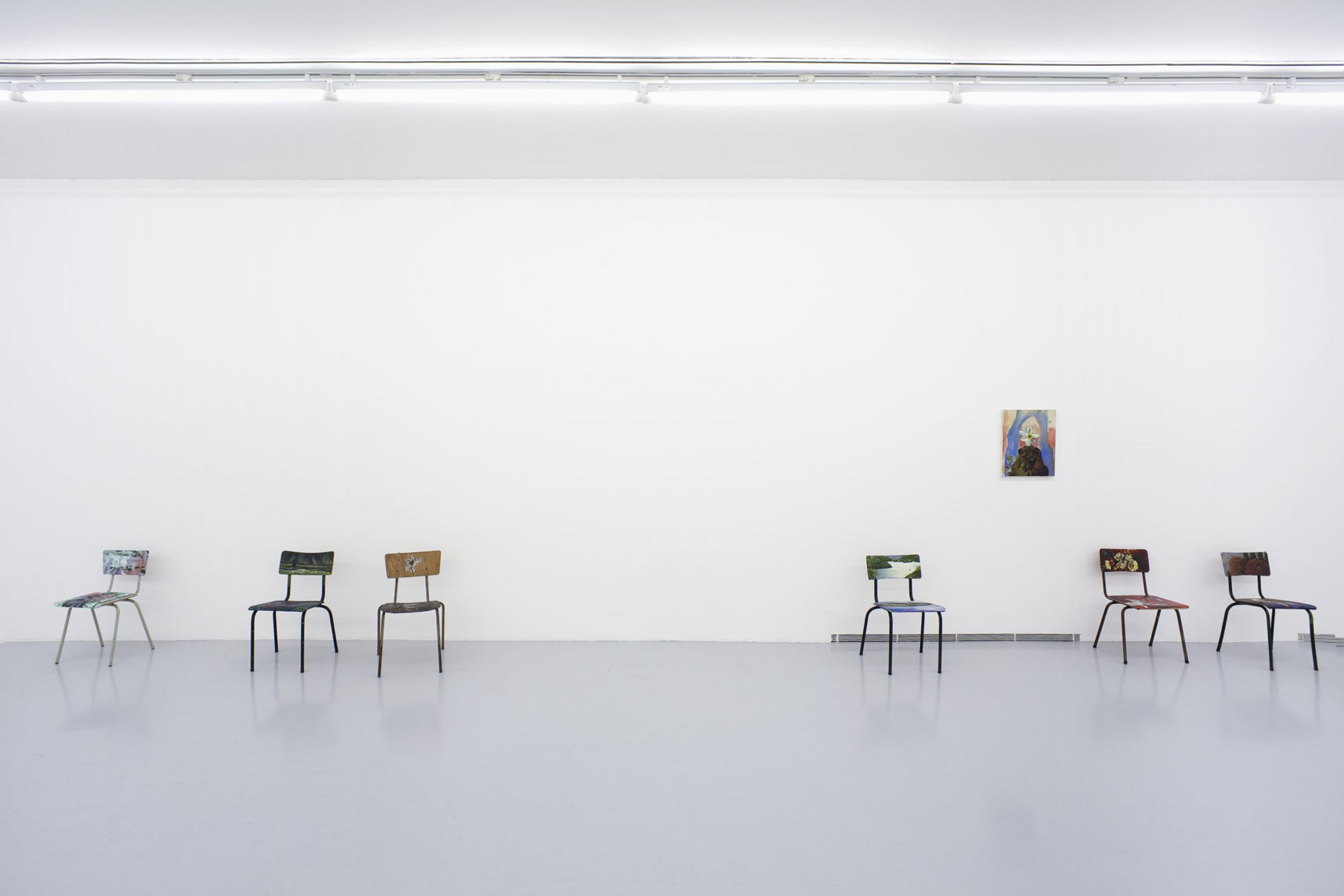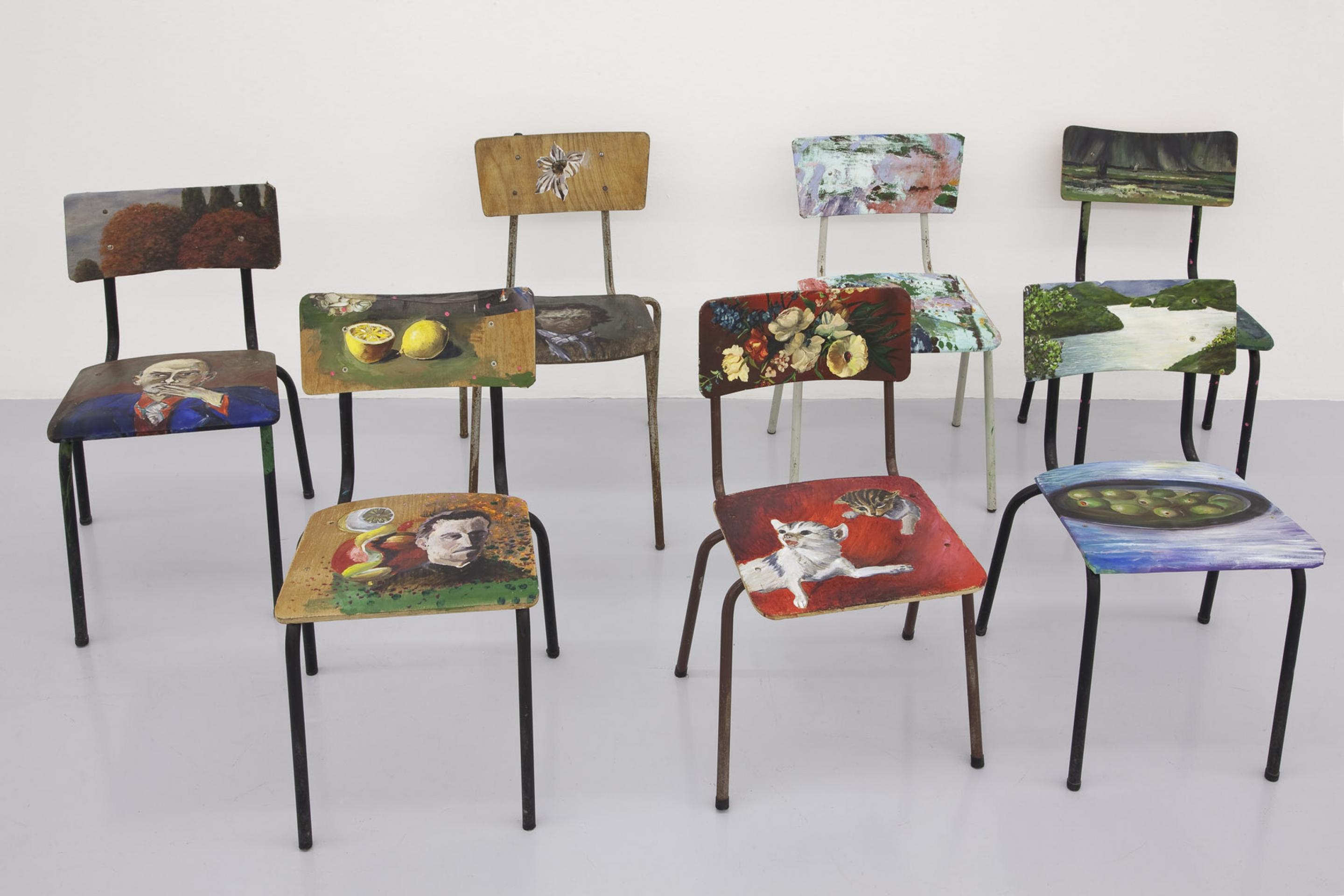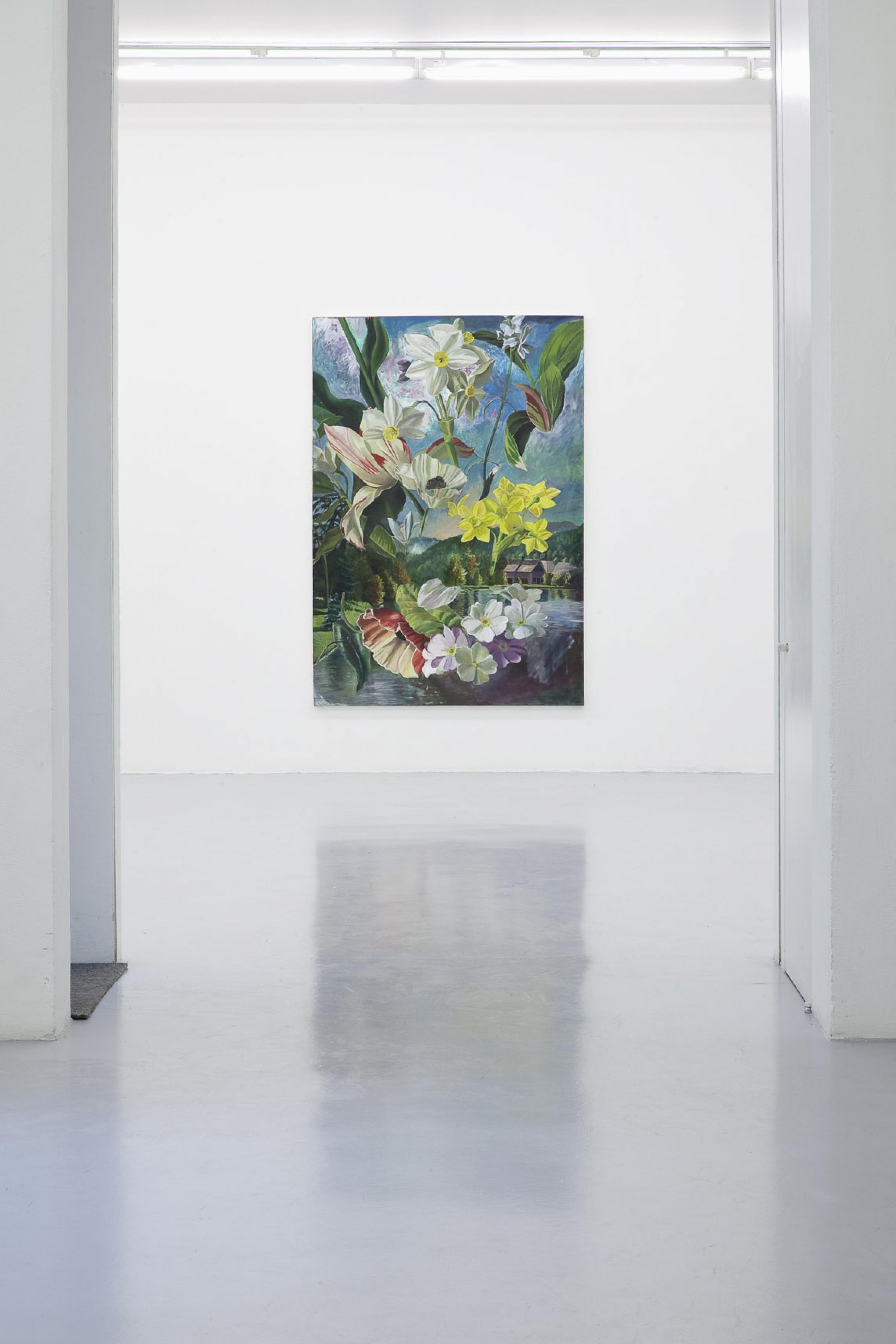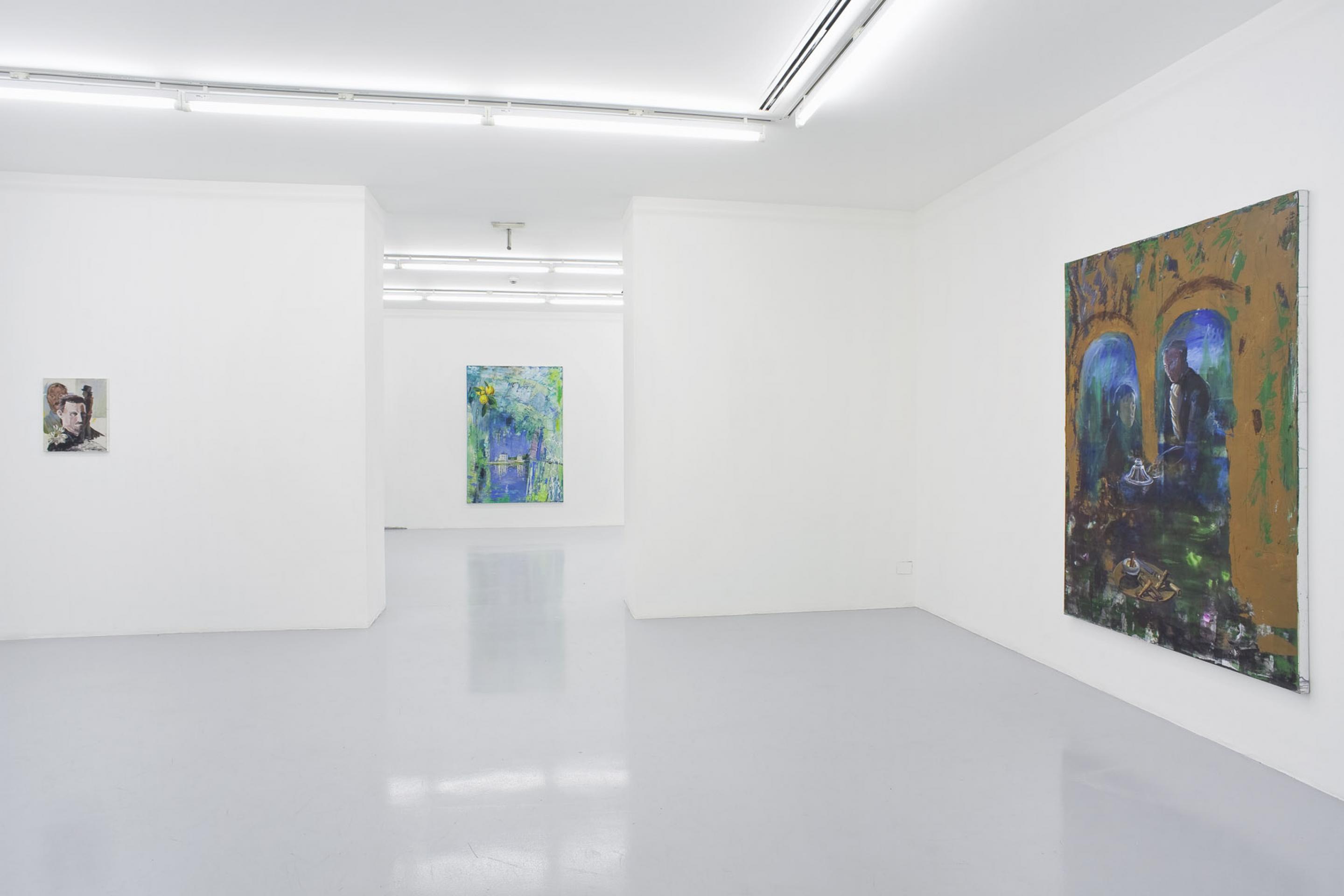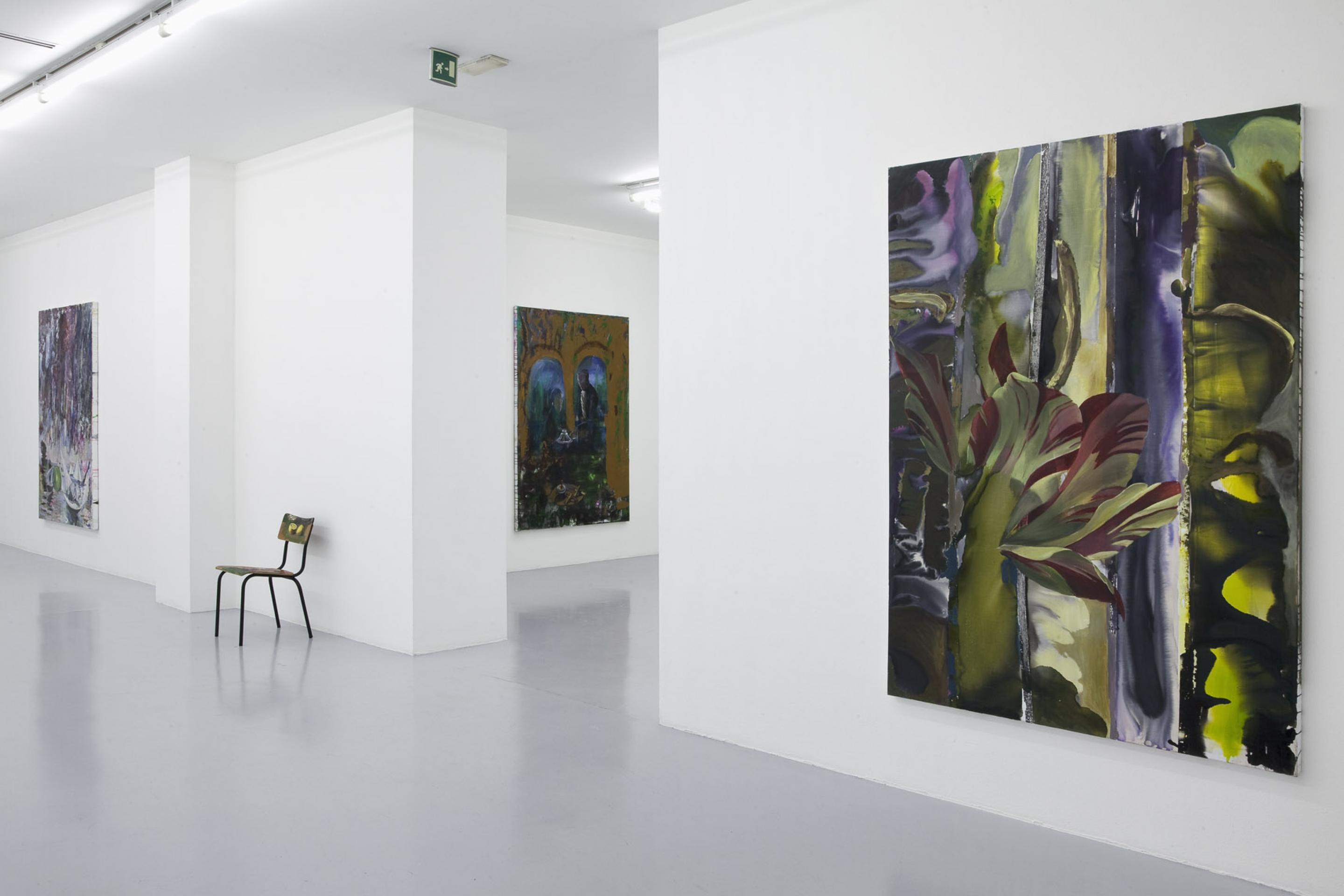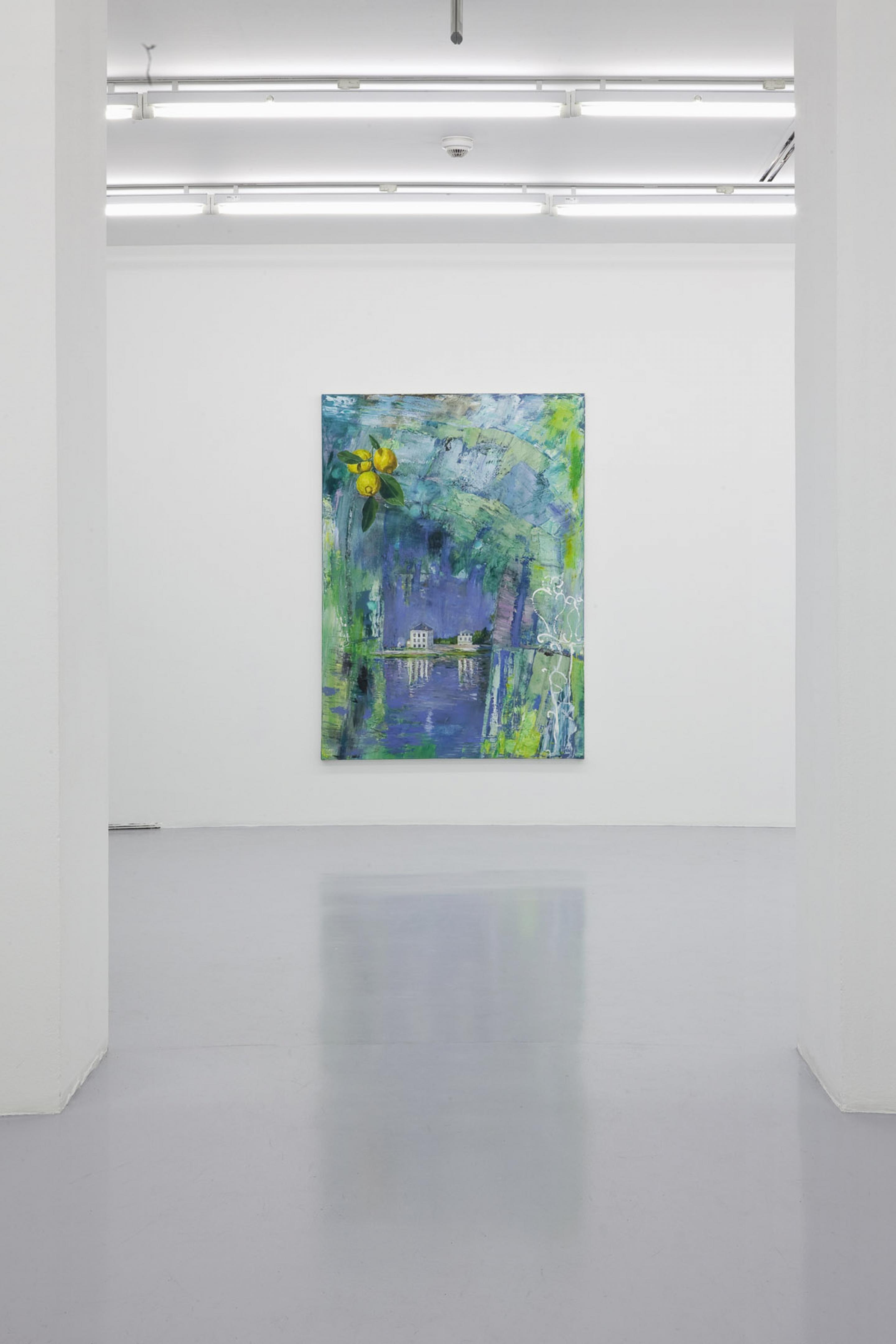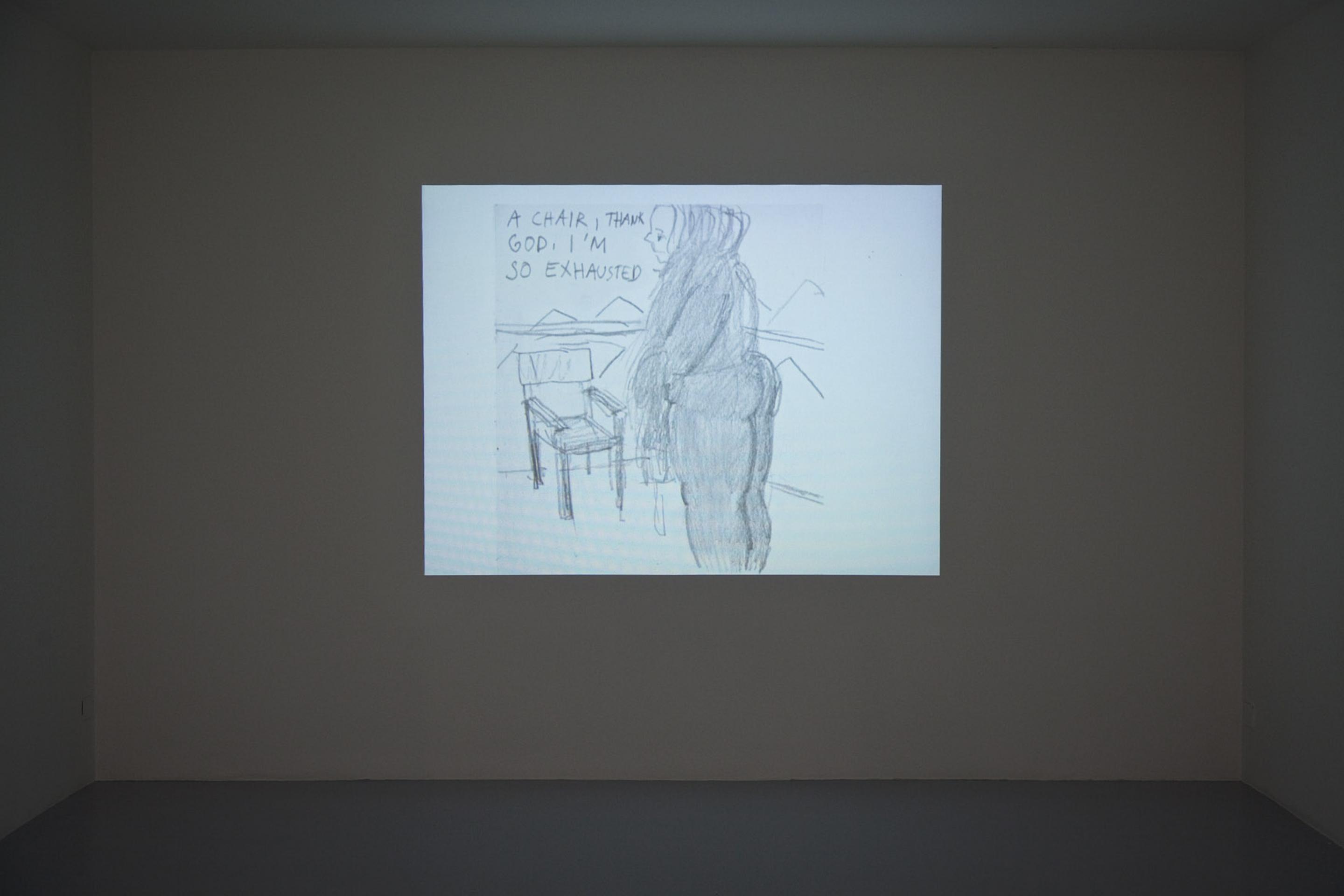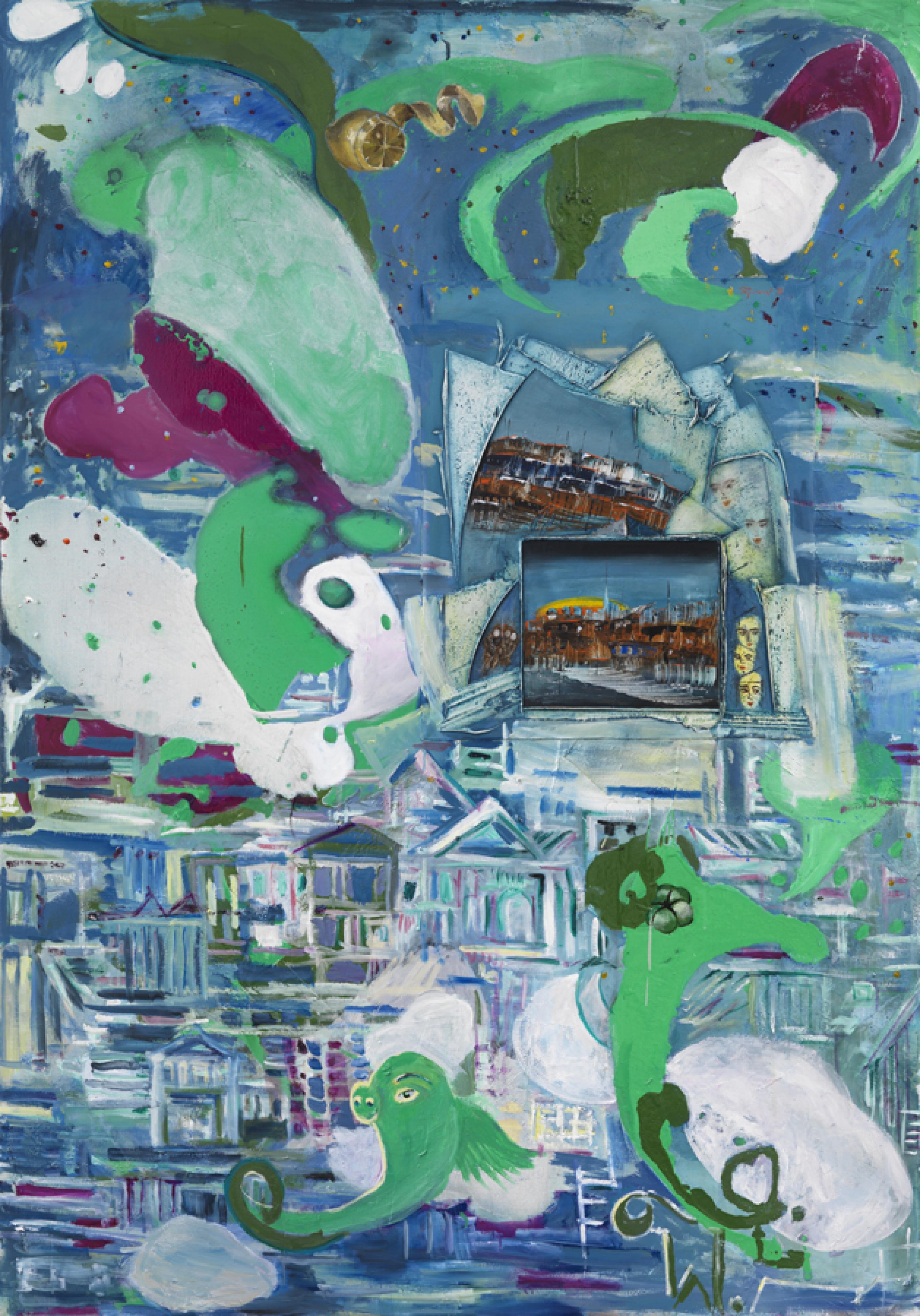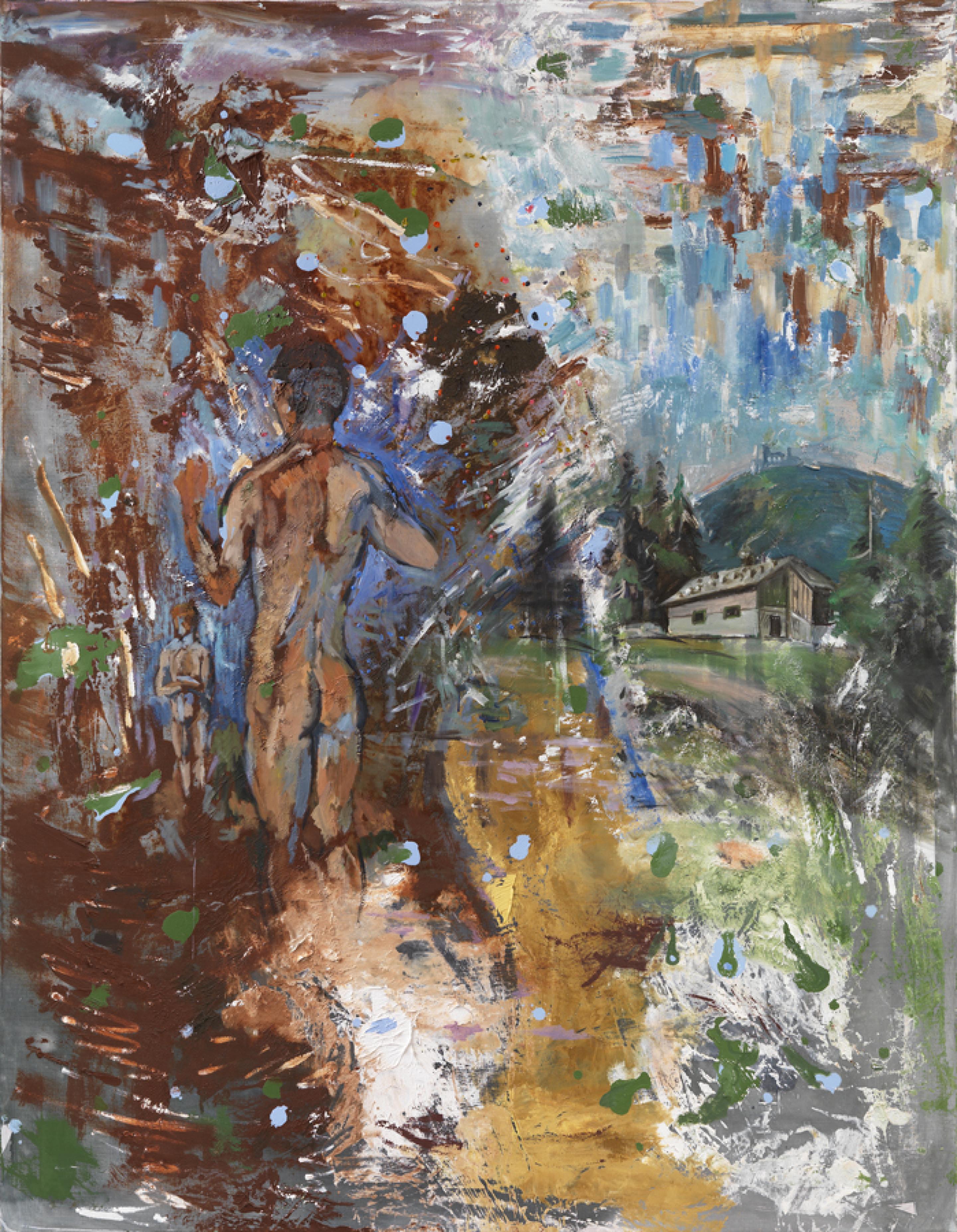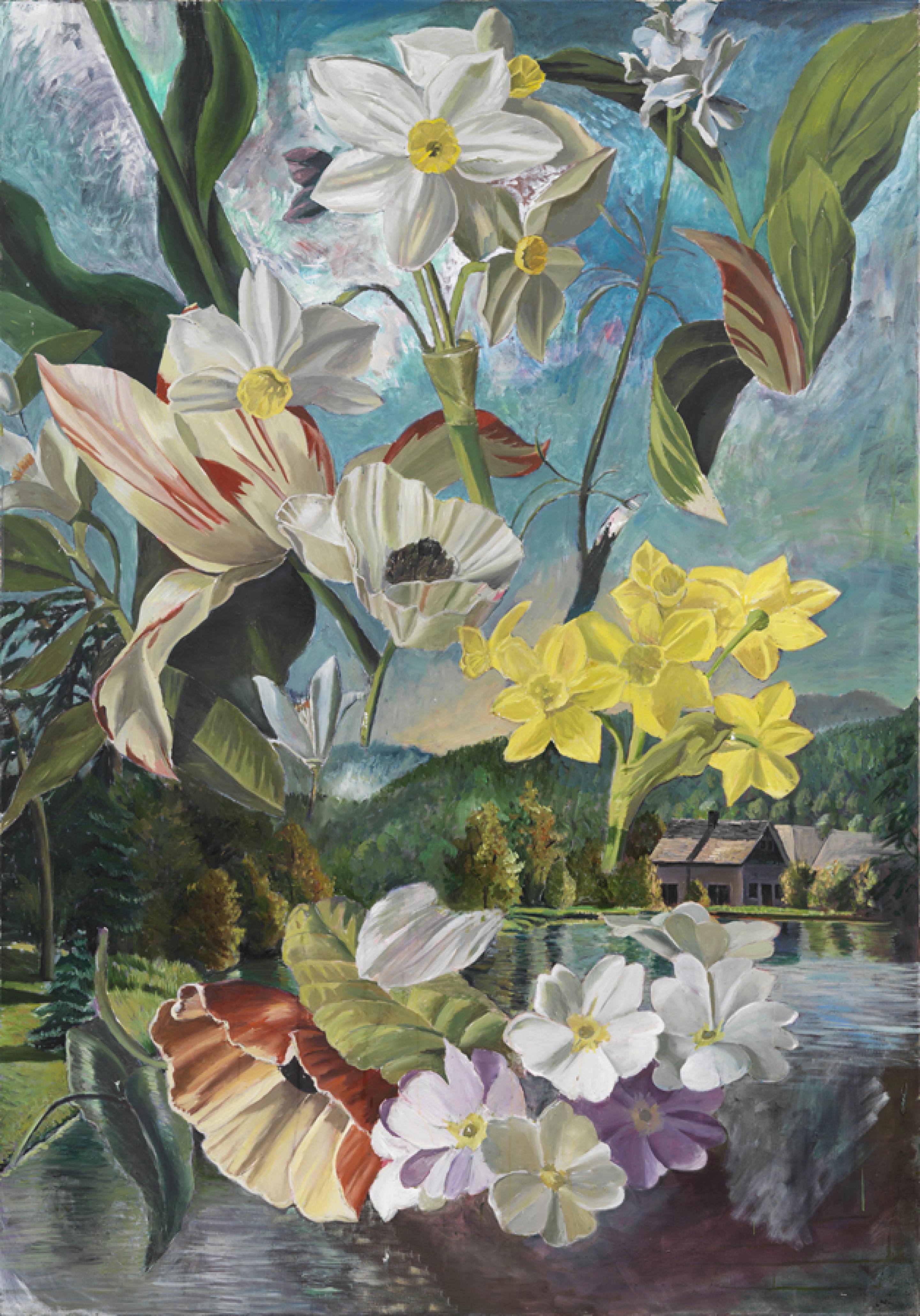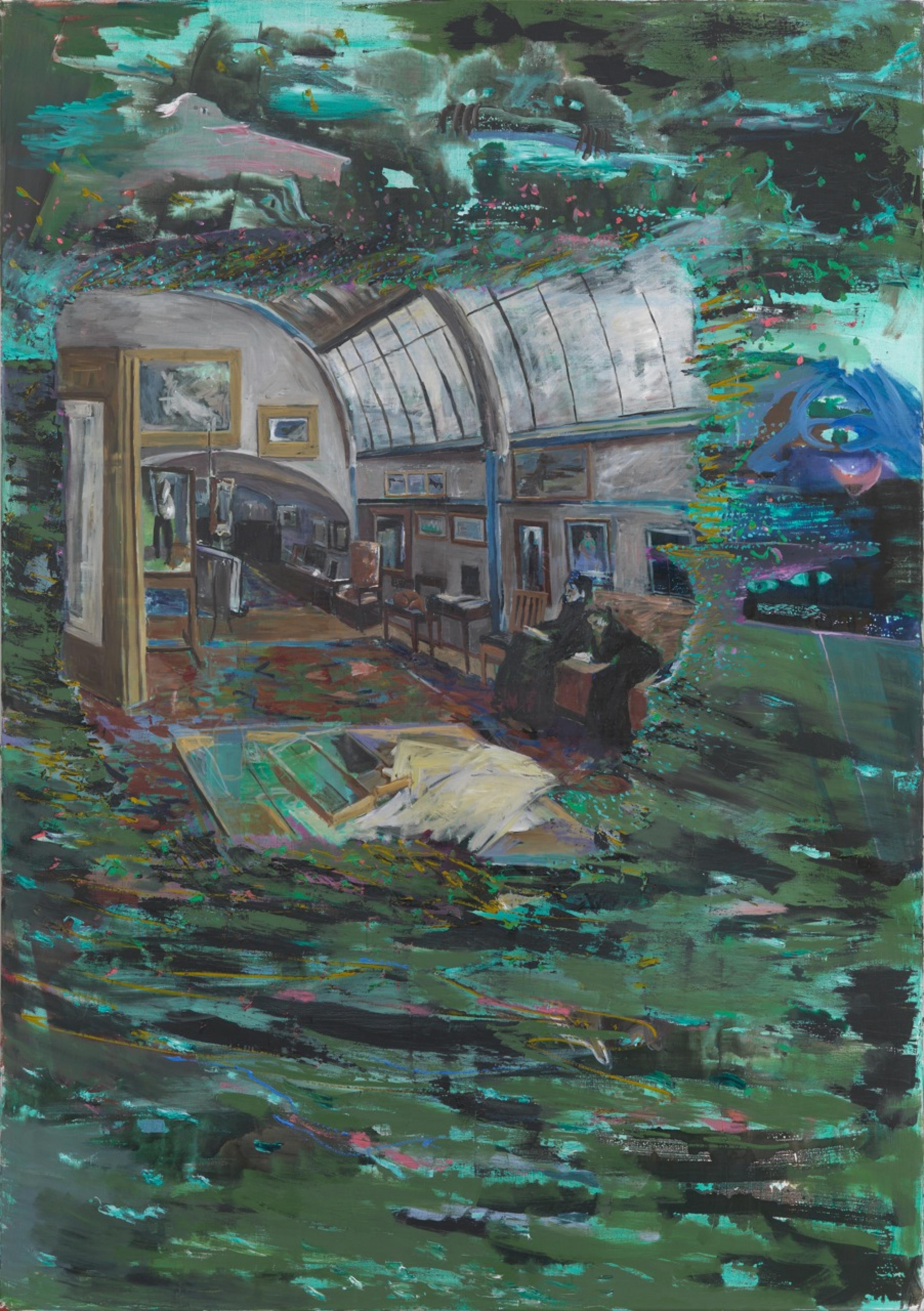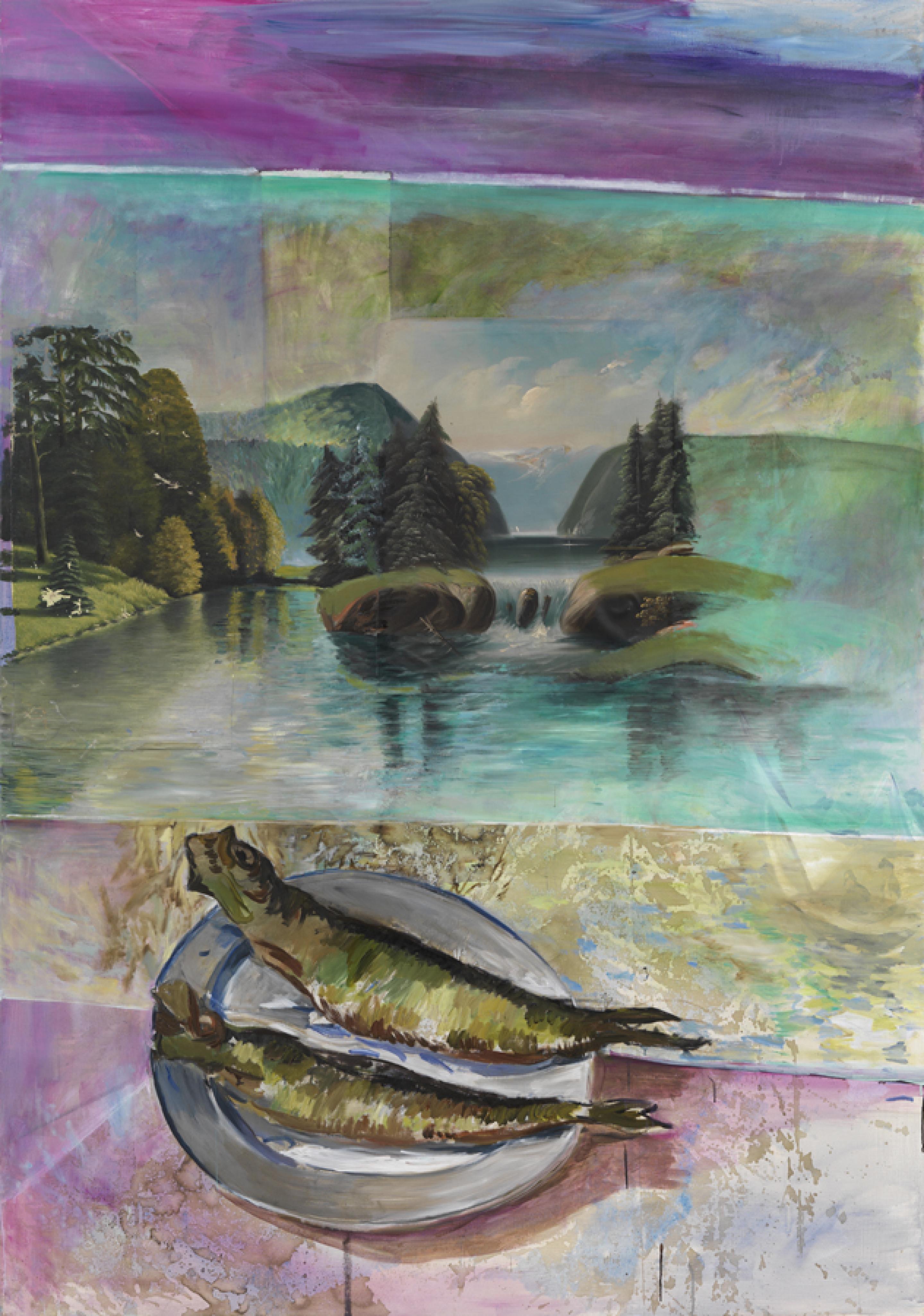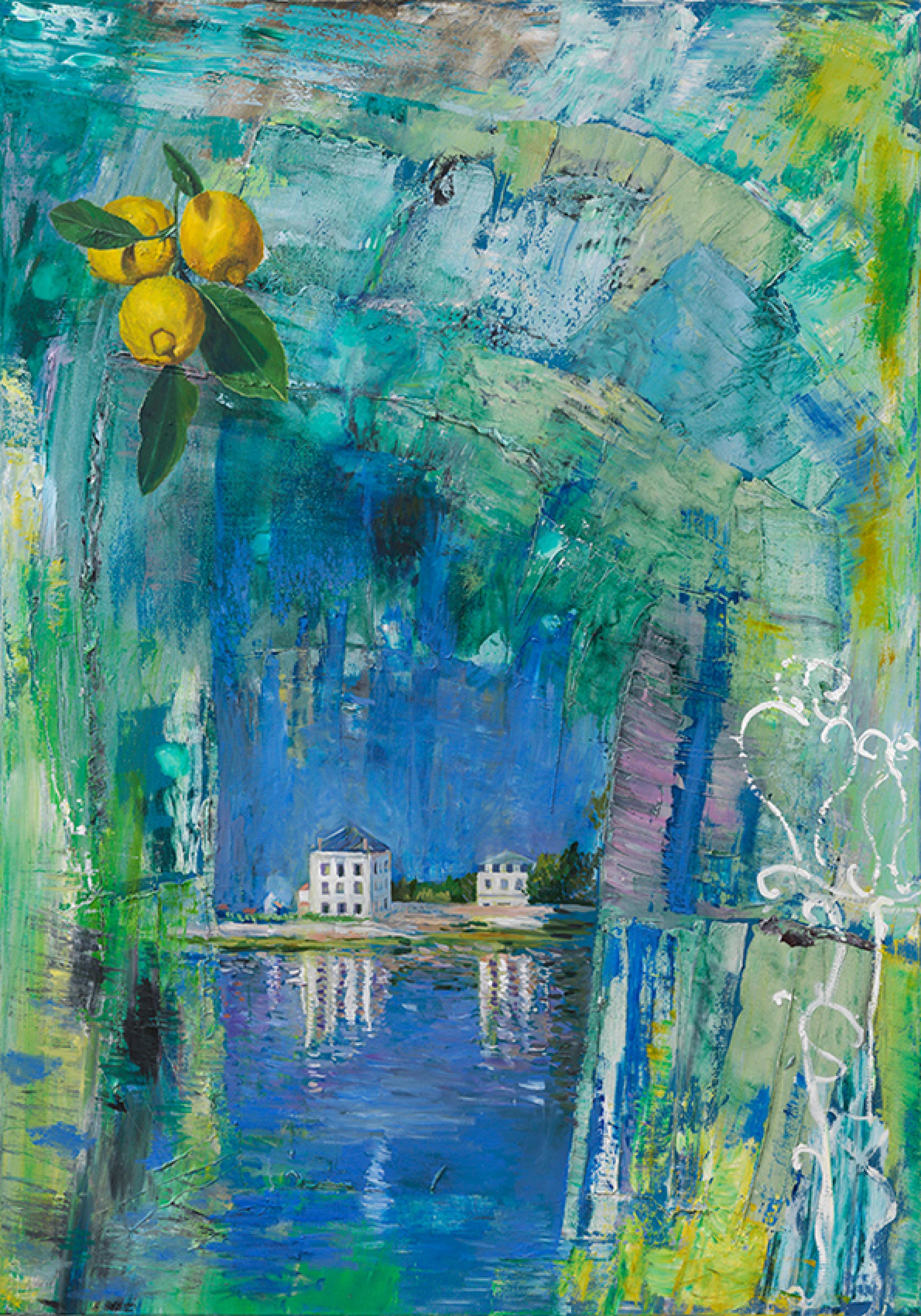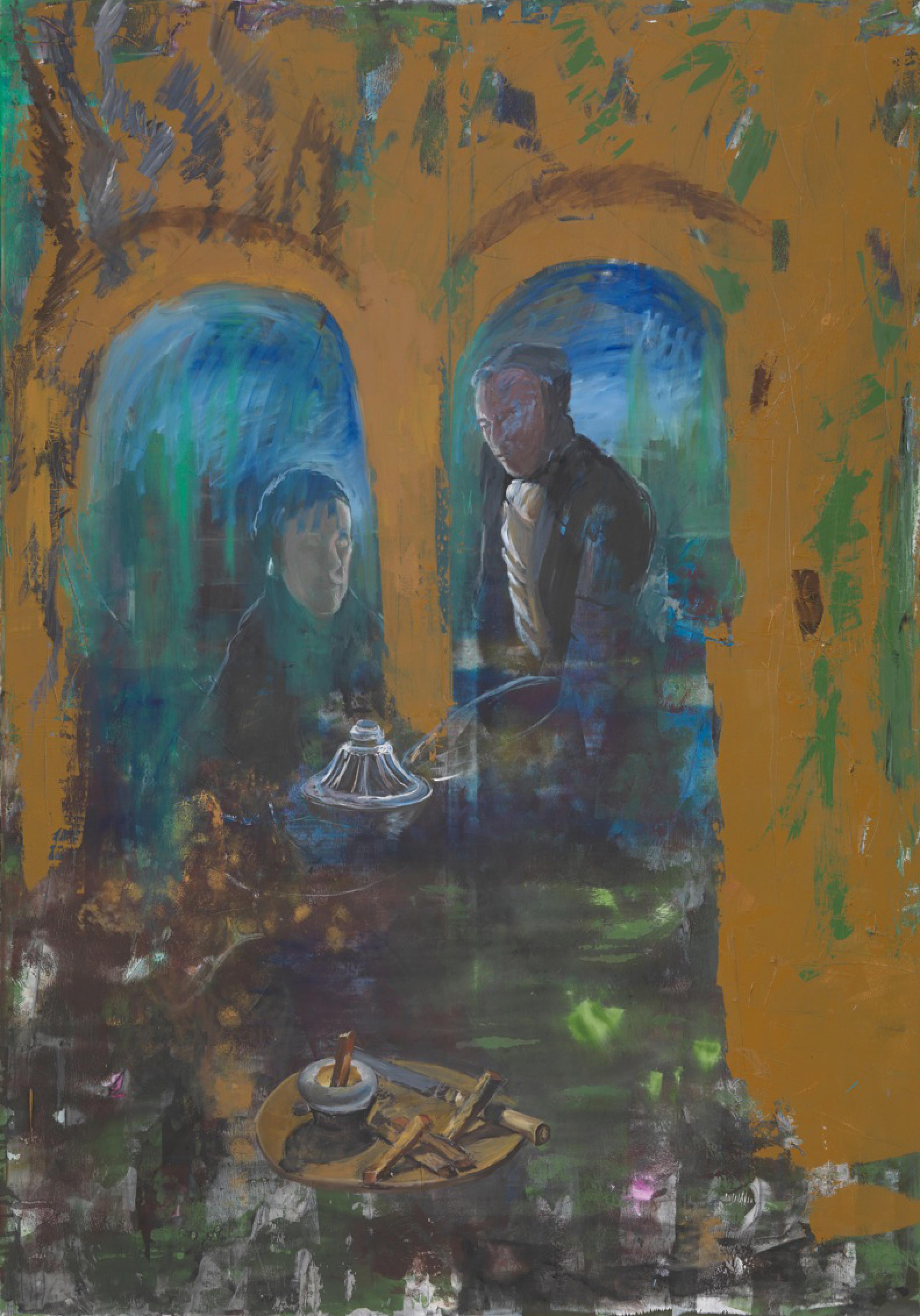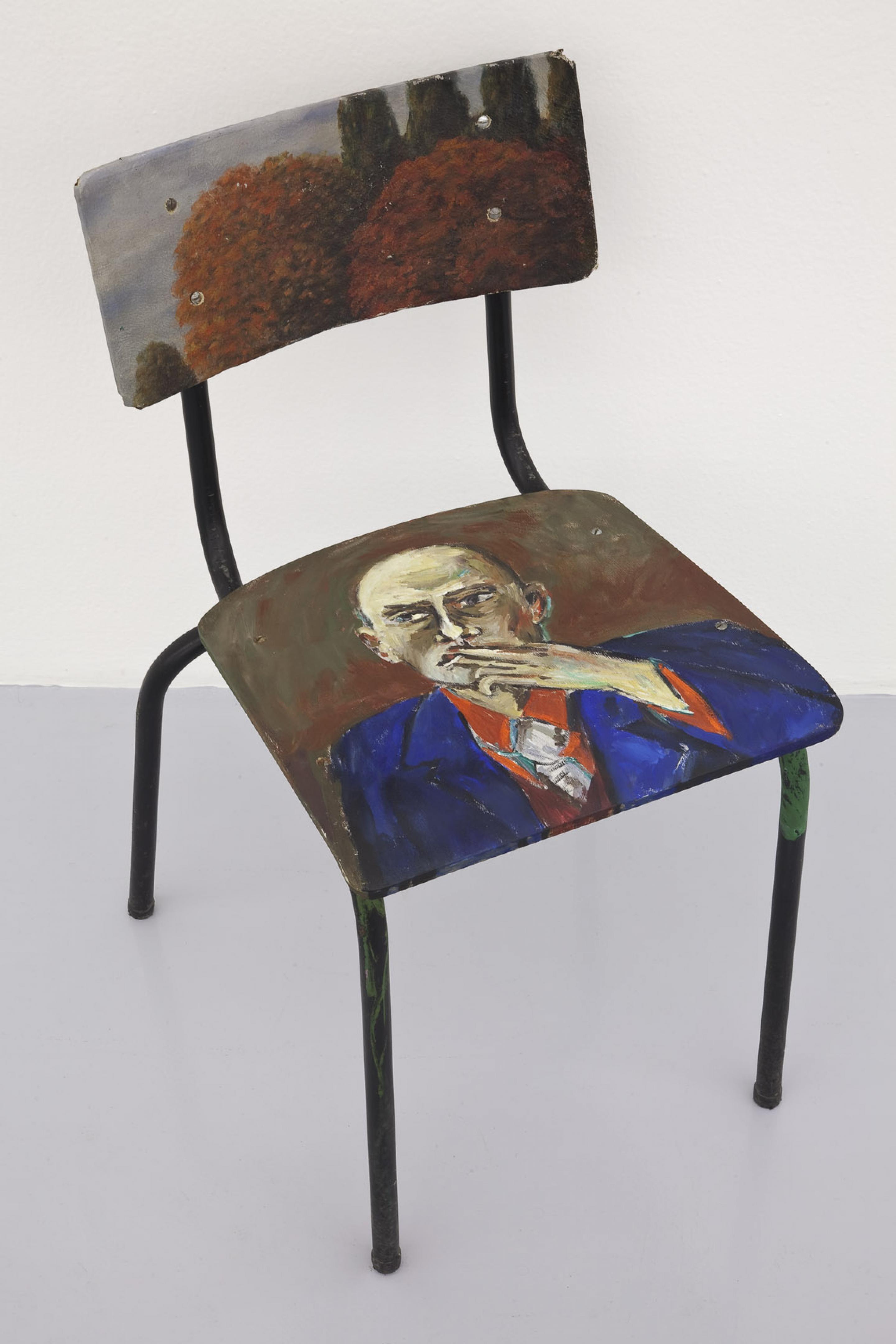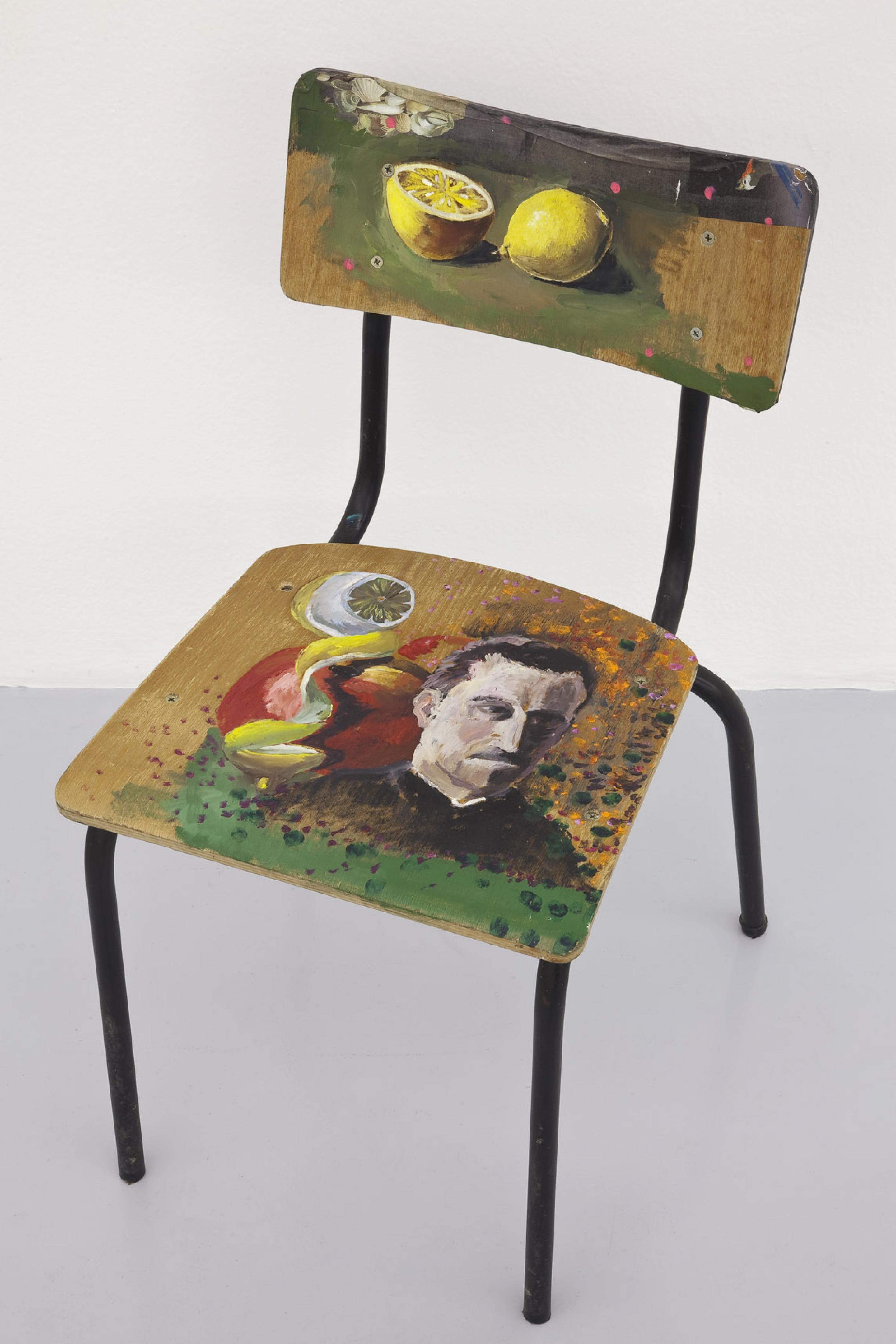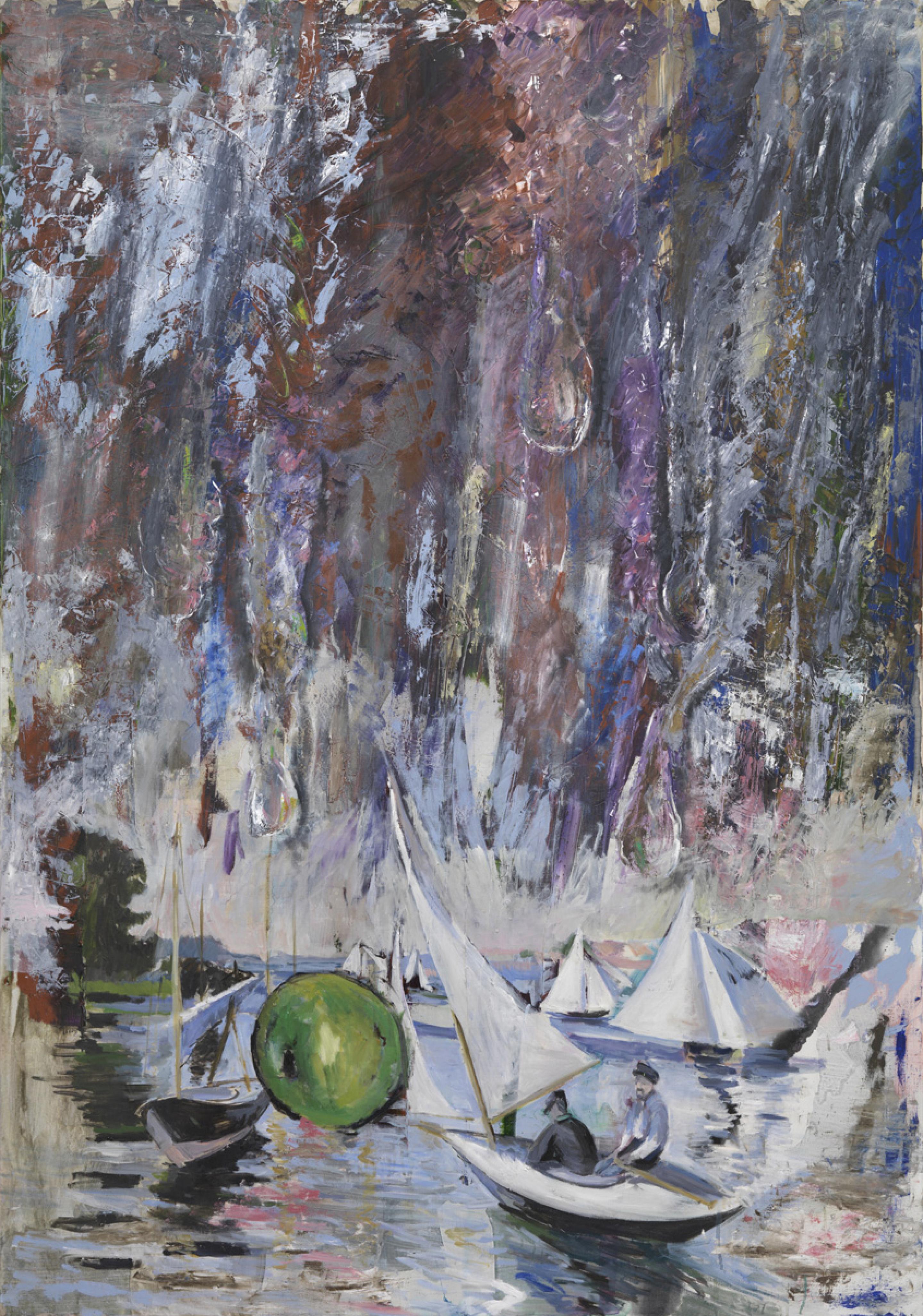AmelieVONWULFFEN
Am kühlen Tisch
Gió Marconi, Milan
28.03.–24.05.2014
Am kühlen Tisch
Gió Marconi, Milan
28.03.–24.05.2014
IT
Amelie von Wulffen
Am kühlen Tisch
Inaugurazione: venerdì 28 marzo 2014 dalle 19 alle 21
29 marzo - 24 maggio 2014
Da martedì a sabato, 10-13; 15-19
Giò Marconi ha il piacere di annunciare Am kühlen Tisch, prima personale dell’artista tedesca Amelie von Wulffen negli spazi della galleria.
Amelie von Wulffen è conosciuta soprattutto per i suoi collage, lavori su carta di grande formato in cui utilizza fotografia, pittura e disegno creando scenari onirici in cui frammenti della vita dell’artista si mescolano ad elementi narrativi fortemente suggestivi ed evocativi. Spazi interiori ed esteriori si sovrappongono confondendosi, come nelle opere della tradizione del Romanticismo e dell’Espressionismo.
Per la personale da Giò Marconi l’artista presenta una nuova serie di lavori pittorici, un fumetto che viene proiettato e alcune sedie dipinte a mano.
Le tele esposte, di grandi dimensioni, raffigurano nature morte, barche galleggianti, scene di interni ed esterni, dove astrazione e figurazione si alternano in maniera originale, accostando forme biomorfe, aree di colore fluide e oggetti più riconoscibili. Alcuni di questi dettagli, come i fiori, i limoni, i paesaggi sono ripresi da opere antiche, e inseriti quindi in un nuovo contesto, in particolare sono presenti molte scene dei dipinti di Gustave Caillebotte.
In due piccole tele compaiono poi gli autoritratti di Max Beckmann, Gustave Caillebotte e Francisco Goya. Von Wulffen ha studiato approfonditamente gli artisti e le opere del XIX e XX secolo, ma non si tratta di un semplice riferimento ad alcuni momenti della storia dell’arte o di una parodia della pittura moderna. Nel riproporre non un ritratto qualsiasi ma l’autoritratto di questi artisti, von Wulffen fa riferimento ad una profonda ammirazione verso le loro opere ma soprattutto al modo in cui questi artisti si vedevano e si consideravano come pittori e come individui.
Questa introspezione, caratteristica di tutto il suo lavoro, emerge chiaramente nel fumetto che viene proiettato, in cui Amelie von Wulffen presenta con grande ironia le paure, le insicurezze e le frustrazioni di un’artista contemporanea a metà della sua carriera.
Qui von Wulffen usa se stessa come protagonista, questo personaggio ha degli aspetti reali ma allo stesso tempo recita una parte, proponendo così un autoritratto molto più fratturato rispetto a quelli dei pittori uomini a cui fa riferimento nelle sue tele.
In un’altra recente serie di opere von Wulffen ha preso spunto oltre che dai fumetti anche dalle illustrazioni per bambini, dipingendo un mondo bucolico popolato da frutta e verdura antropomorfa. Giocosi e irriverenti acquerelli dove vegetali di ogni tipo vengono colti in situazioni perverse e umilianti. Il riferimento è ai Capricci di Goya.
Lo stile leggero che ricorda quello dei libri per bambini nasconde però temi e sentimenti umani più complessi come la solitudine, la violenza, il fallimento e l’umiliazione.
Spesso le opere di von Wulffen superano i limiti della tela sconfinando nello spazio espositivo come pittura murale o come mobili. Qui spazio individuale e collettivo convergono: l’identità di von Wulffen dialoga con la storia degli spettatori. Sedendosi su una delle sedie dipinte a mano dall’artista ci si trova coinvolti direttamente con le sue paure e di conseguenza si è costretti a confrontarsi anche con le proprie.
Tutto il lavoro di von Wulffen parte dalla sua esperienza autobiografica per esplorare la memoria collettiva.
Amelie VON WULFFEN è nata a Breitenbrunn, in Germania nel 1966. Ha studiato all’Academy of Fine Arts di Monaco e ha insegnato pittura all’Academy of Fine Arts di Vienna dal 2006 al 2011.
Attualmente vive e lavora a Berlino.
Tra le sue recenti mostre personali: Portikus, Francoforte; Galerie Meyer Kainer, Vienna (2013); Aspen Art Museum (2012); Greene Naftali Gallery, New York; This Is How It Happened, Alex Zachary Gallery, New York (2011); Bitte keine heiße Asche einfüllen, Galerie Crone, Berlino (2010); Kunstraum Innsbruck (2009); Chucky und die Silberdistel, Gabriele Senn Galerie, Vienna; Die Vertuschung, Galerie Almine Rech, Parigi (2008); Kunstverein für die Rheinlande und Westfalen, Düsseldorf (2006); Espace 315, Centre Pompidou, Parigi; Kunstmuseum Basel, Museum für Gegenwartskunst (2005).
Inoltre ha partecipato anche a diverse mostre collettive, tra cui: Nadira Husain, Ella Kruglyanskaya, Birgit Megerle, Amelie von Wulffen, Galerie Tobias Nähring, Lipsia; Painting Forever! Keilrahmen, Kunstwerke, Berlino; Homes and gardens, Freedman Fitzpatrick, Los Angeles; Vertical Club, curata da Will Benedict, Bortolami Gallery, New York (2013); ABC Art Berlin Contemporary, Alex Zachary Peter Currie (solo presentation); Buy My Bananas, Kate Werble Gallery, New York; Context Message, Zach Feuer Gallery, New York; Make Me Like It!, Vacant Galleries, Vienna; Malerei in Fotografie, Städel Museum, Francoforte (2012); Compass: Drawings from The Museum of Modern Art, New York; Martin-Gropius-Bau, Berlino; Happy Holidays! Drawings, Alex Zachary Gallery, New York (2011); 3rd Berlin Biennial for Contemporary Art (2004); Dreams and Conflicts: The Dictatorship of the Viewer, 50esima Biennale di Venezia (2003).
Il suo lavoro è presente in numerose collezioni pubbliche, tra cui: Centre Pompidou, Musée National d’Art Moderne, Parigi; Hammer Museum, University of California, Los Angeles; Museum of Contemporary Art, Los Angeles; Museum of Modern Art, New York; Fonds régional d'art contemporain (FRAC) Auvergne, Clermont-Ferrand; Die Sammlung zeitgenössischer Kunst der Bundesrepublik Deutschland, Bonn ; Staatliche Museen zu Berlin, Kupferstichkabinett, Berlino; Städel Museum, Francoforte.
Am kühlen Tisch
Inaugurazione: venerdì 28 marzo 2014 dalle 19 alle 21
29 marzo - 24 maggio 2014
Da martedì a sabato, 10-13; 15-19
Giò Marconi ha il piacere di annunciare Am kühlen Tisch, prima personale dell’artista tedesca Amelie von Wulffen negli spazi della galleria.
Amelie von Wulffen è conosciuta soprattutto per i suoi collage, lavori su carta di grande formato in cui utilizza fotografia, pittura e disegno creando scenari onirici in cui frammenti della vita dell’artista si mescolano ad elementi narrativi fortemente suggestivi ed evocativi. Spazi interiori ed esteriori si sovrappongono confondendosi, come nelle opere della tradizione del Romanticismo e dell’Espressionismo.
Per la personale da Giò Marconi l’artista presenta una nuova serie di lavori pittorici, un fumetto che viene proiettato e alcune sedie dipinte a mano.
Le tele esposte, di grandi dimensioni, raffigurano nature morte, barche galleggianti, scene di interni ed esterni, dove astrazione e figurazione si alternano in maniera originale, accostando forme biomorfe, aree di colore fluide e oggetti più riconoscibili. Alcuni di questi dettagli, come i fiori, i limoni, i paesaggi sono ripresi da opere antiche, e inseriti quindi in un nuovo contesto, in particolare sono presenti molte scene dei dipinti di Gustave Caillebotte.
In due piccole tele compaiono poi gli autoritratti di Max Beckmann, Gustave Caillebotte e Francisco Goya. Von Wulffen ha studiato approfonditamente gli artisti e le opere del XIX e XX secolo, ma non si tratta di un semplice riferimento ad alcuni momenti della storia dell’arte o di una parodia della pittura moderna. Nel riproporre non un ritratto qualsiasi ma l’autoritratto di questi artisti, von Wulffen fa riferimento ad una profonda ammirazione verso le loro opere ma soprattutto al modo in cui questi artisti si vedevano e si consideravano come pittori e come individui.
Questa introspezione, caratteristica di tutto il suo lavoro, emerge chiaramente nel fumetto che viene proiettato, in cui Amelie von Wulffen presenta con grande ironia le paure, le insicurezze e le frustrazioni di un’artista contemporanea a metà della sua carriera.
Qui von Wulffen usa se stessa come protagonista, questo personaggio ha degli aspetti reali ma allo stesso tempo recita una parte, proponendo così un autoritratto molto più fratturato rispetto a quelli dei pittori uomini a cui fa riferimento nelle sue tele.
In un’altra recente serie di opere von Wulffen ha preso spunto oltre che dai fumetti anche dalle illustrazioni per bambini, dipingendo un mondo bucolico popolato da frutta e verdura antropomorfa. Giocosi e irriverenti acquerelli dove vegetali di ogni tipo vengono colti in situazioni perverse e umilianti. Il riferimento è ai Capricci di Goya.
Lo stile leggero che ricorda quello dei libri per bambini nasconde però temi e sentimenti umani più complessi come la solitudine, la violenza, il fallimento e l’umiliazione.
Spesso le opere di von Wulffen superano i limiti della tela sconfinando nello spazio espositivo come pittura murale o come mobili. Qui spazio individuale e collettivo convergono: l’identità di von Wulffen dialoga con la storia degli spettatori. Sedendosi su una delle sedie dipinte a mano dall’artista ci si trova coinvolti direttamente con le sue paure e di conseguenza si è costretti a confrontarsi anche con le proprie.
Tutto il lavoro di von Wulffen parte dalla sua esperienza autobiografica per esplorare la memoria collettiva.
Amelie VON WULFFEN è nata a Breitenbrunn, in Germania nel 1966. Ha studiato all’Academy of Fine Arts di Monaco e ha insegnato pittura all’Academy of Fine Arts di Vienna dal 2006 al 2011.
Attualmente vive e lavora a Berlino.
Tra le sue recenti mostre personali: Portikus, Francoforte; Galerie Meyer Kainer, Vienna (2013); Aspen Art Museum (2012); Greene Naftali Gallery, New York; This Is How It Happened, Alex Zachary Gallery, New York (2011); Bitte keine heiße Asche einfüllen, Galerie Crone, Berlino (2010); Kunstraum Innsbruck (2009); Chucky und die Silberdistel, Gabriele Senn Galerie, Vienna; Die Vertuschung, Galerie Almine Rech, Parigi (2008); Kunstverein für die Rheinlande und Westfalen, Düsseldorf (2006); Espace 315, Centre Pompidou, Parigi; Kunstmuseum Basel, Museum für Gegenwartskunst (2005).
Inoltre ha partecipato anche a diverse mostre collettive, tra cui: Nadira Husain, Ella Kruglyanskaya, Birgit Megerle, Amelie von Wulffen, Galerie Tobias Nähring, Lipsia; Painting Forever! Keilrahmen, Kunstwerke, Berlino; Homes and gardens, Freedman Fitzpatrick, Los Angeles; Vertical Club, curata da Will Benedict, Bortolami Gallery, New York (2013); ABC Art Berlin Contemporary, Alex Zachary Peter Currie (solo presentation); Buy My Bananas, Kate Werble Gallery, New York; Context Message, Zach Feuer Gallery, New York; Make Me Like It!, Vacant Galleries, Vienna; Malerei in Fotografie, Städel Museum, Francoforte (2012); Compass: Drawings from The Museum of Modern Art, New York; Martin-Gropius-Bau, Berlino; Happy Holidays! Drawings, Alex Zachary Gallery, New York (2011); 3rd Berlin Biennial for Contemporary Art (2004); Dreams and Conflicts: The Dictatorship of the Viewer, 50esima Biennale di Venezia (2003).
Il suo lavoro è presente in numerose collezioni pubbliche, tra cui: Centre Pompidou, Musée National d’Art Moderne, Parigi; Hammer Museum, University of California, Los Angeles; Museum of Contemporary Art, Los Angeles; Museum of Modern Art, New York; Fonds régional d'art contemporain (FRAC) Auvergne, Clermont-Ferrand; Die Sammlung zeitgenössischer Kunst der Bundesrepublik Deutschland, Bonn ; Staatliche Museen zu Berlin, Kupferstichkabinett, Berlino; Städel Museum, Francoforte.
EN
Amelie von Wulffen
Am kühlen Tisch
Opening: Friday, March 28, 2014; 7 - 9 PM
March 29 - May 24 2014
From Tuesday to Saturday, 10-1; 3-7
Giò Marconi is very pleased to announce Am kühlen Tisch an exhibition of new works by German artist Amelie von Wulffen. This is the artist’s first solo show with the gallery.
Amelie von Wulffen is best known for her collages, large-scale works on paper where she includes photography, painting and drawing and creates dreamlike scenarios in which fragments of the artist's life are mixed with strongly suggestive and evocative narrative elements. Interior and exterior spaces overlap and blend together, like in the works of Romanticism and Expressionism tradition.
The show at Giò Marconi features a new series of paintings, a slideshow of her latest comic and a group of hand-painted chairs.
The paintings on display are large canvases depicting still life, floating boats, indoor and outdoor scenes, where abstraction and figuration are mixed in an original manner, associating biomorphic shapes to fluid and organic areas of colour and more recognisable objects. Quite a few details of these works as flowers, lemons, landscapes are taken from ancient paintings and put into a new space, in particular the paintings of Gustave Caillebotte appear quite a lot.
Then there are two small canvases showing the self-portraits by Max Beckmann, Gustave Caillebotte and Francisco Goya. Von Wulffen studied extensively the artists and the works from Nineteenth and Twentieth century, but this is not just a reference to some moments in the history of art or a kind of parody of modern painting. As she re-proposes these artists' self-portraits and not just any portraits, von Wulffen refers to a deep admiration for their works and also to the way these artists saw themselves as painters and individuals.
This introspection is a characteristic that features throughout the artist's work and is evident in the comic on view as a slideshow in which Amelie von Wulffen presents with great irony the fears, the insecurities and the frustration of a mid-career artist working today.
Here von Wulffen is using herself as a character, this character has authentic aspects, but is also playing a role and thereby she is proposing a more fractured self-portrait than the ones of the male painters she is referring to.
In another recent series of works, von Wulffen got inspiration from comics as well as also from children’s illustrations and painted a bucolic world populated by anthropomorphic fruits and vegetables. A series of playful and irreverent watercolours where veggies of all kinds are caught in perverted and humiliating situations. The reference here is to Goya’s Capriccios. Her soft style reminds that of children's books; however, it hides more complex issues and human feelings such as loneliness, violence, failure and humiliation.
Von Wulffen’s works often go far beyond the boundaries of the canvas, extending into the exhibition space in the form of wall paintings and furniture. Here individual and collective space converge: von Wulffen’s identity dialogues with the audience’s history. Sitting on one of the chairs hand-painted by the artist viewers find themselves caught in her dilemmas and so they are forced to negotiate with their own fears.
All the work by von Wulffen starts from her autobiographical experience to explore the collective memory.
Amelie VON WULFFEN is born in Breitenbrunn, Germany in 1966. She studied at the Academy of Fine Arts Munich and she was Professor of Painting at the Academy of Fine Arts Vienna from 2006 to 2011. She currently lives and works in Berlin.
Recent solo exhibitions include: Portikus, Frankfurt; Galerie Meyer Kainer, Vienna (2013); Aspen Art Museum (2012); Greene Naftali Gallery, New York; This Is How It Happened, Alex Zachary Gallery, New York (2011); Bitte keine heiße Asche einfüllen, Galerie Crone, Berlin (2010); Kunstraum Innsbruck (2009); Chucky und die Silberdistel, Gabriele Senn Galerie, Vienna; Die Vertuschung, Galerie Almine Rech, Paris (2008); Kunstverein für die Rheinlande und Westfalen, Düsseldorf (2006); Espace 315, Centre Pompidou, Paris; Kunstmuseum Basel, Museum für Gegenwartskunst (2005).
Furthermore she has participated in numerous group shows including: Nadira Husain, Ella Kruglyanskaya, Birgit Megerle, Amelie von Wulffen, Galerie Tobias Nähring, Leipzig; Painting Forever! Keilrahmen, Kunstwerke, Berlin; Homes and gardens, Freedman Fitzpatrick, Los Angeles; Vertical Club, curated by Will Benedict, Bortolami Gallery, New York (2013); ABC Art Berlin Contemporary, Alex Zachary Peter Currie (solo presentation); Buy My Bananas, Kate Werble Gallery, New York; Context Message, Zach Feuer Gallery, New York; Make Me Like It!, Vacant Galleries, Vienna; Malerei in Fotografie, Städel Museum, Frankfurt (2012); Compass: Drawings from The Museum of Modern Art, New York; Martin-Gropius-Bau, Berlin; Happy Holidays! Drawings, Alex Zachary Gallery, New York (2011); 3rd Berlin Biennial for Contemporary Art (2004); Dreams and Conflicts: The Dictatorship of the Viewer, 50th Venice Biennal (2003).
She is represented in important public collections, amongst them: Centre Pompidou, Musée National d’Art Moderne, Paris; Hammer Museum, University of California, Los Angeles; Museum of Contemporary Art, Los Angeles; Museum of Modern Art, New York; Fonds régional d'art contemporain (FRAC) Auvergne, Clermont-Ferrand Die Sammlung zeitgenössischer Kunst der Bundesrepublik Deutschland, Bonn ; Staatliche Museen zu Berlin, Kupferstichkabinett, Berlin; Städel Museum, Frankfurt.
Am kühlen Tisch
Opening: Friday, March 28, 2014; 7 - 9 PM
March 29 - May 24 2014
From Tuesday to Saturday, 10-1; 3-7
Giò Marconi is very pleased to announce Am kühlen Tisch an exhibition of new works by German artist Amelie von Wulffen. This is the artist’s first solo show with the gallery.
Amelie von Wulffen is best known for her collages, large-scale works on paper where she includes photography, painting and drawing and creates dreamlike scenarios in which fragments of the artist's life are mixed with strongly suggestive and evocative narrative elements. Interior and exterior spaces overlap and blend together, like in the works of Romanticism and Expressionism tradition.
The show at Giò Marconi features a new series of paintings, a slideshow of her latest comic and a group of hand-painted chairs.
The paintings on display are large canvases depicting still life, floating boats, indoor and outdoor scenes, where abstraction and figuration are mixed in an original manner, associating biomorphic shapes to fluid and organic areas of colour and more recognisable objects. Quite a few details of these works as flowers, lemons, landscapes are taken from ancient paintings and put into a new space, in particular the paintings of Gustave Caillebotte appear quite a lot.
Then there are two small canvases showing the self-portraits by Max Beckmann, Gustave Caillebotte and Francisco Goya. Von Wulffen studied extensively the artists and the works from Nineteenth and Twentieth century, but this is not just a reference to some moments in the history of art or a kind of parody of modern painting. As she re-proposes these artists' self-portraits and not just any portraits, von Wulffen refers to a deep admiration for their works and also to the way these artists saw themselves as painters and individuals.
This introspection is a characteristic that features throughout the artist's work and is evident in the comic on view as a slideshow in which Amelie von Wulffen presents with great irony the fears, the insecurities and the frustration of a mid-career artist working today.
Here von Wulffen is using herself as a character, this character has authentic aspects, but is also playing a role and thereby she is proposing a more fractured self-portrait than the ones of the male painters she is referring to.
In another recent series of works, von Wulffen got inspiration from comics as well as also from children’s illustrations and painted a bucolic world populated by anthropomorphic fruits and vegetables. A series of playful and irreverent watercolours where veggies of all kinds are caught in perverted and humiliating situations. The reference here is to Goya’s Capriccios. Her soft style reminds that of children's books; however, it hides more complex issues and human feelings such as loneliness, violence, failure and humiliation.
Von Wulffen’s works often go far beyond the boundaries of the canvas, extending into the exhibition space in the form of wall paintings and furniture. Here individual and collective space converge: von Wulffen’s identity dialogues with the audience’s history. Sitting on one of the chairs hand-painted by the artist viewers find themselves caught in her dilemmas and so they are forced to negotiate with their own fears.
All the work by von Wulffen starts from her autobiographical experience to explore the collective memory.
Amelie VON WULFFEN is born in Breitenbrunn, Germany in 1966. She studied at the Academy of Fine Arts Munich and she was Professor of Painting at the Academy of Fine Arts Vienna from 2006 to 2011. She currently lives and works in Berlin.
Recent solo exhibitions include: Portikus, Frankfurt; Galerie Meyer Kainer, Vienna (2013); Aspen Art Museum (2012); Greene Naftali Gallery, New York; This Is How It Happened, Alex Zachary Gallery, New York (2011); Bitte keine heiße Asche einfüllen, Galerie Crone, Berlin (2010); Kunstraum Innsbruck (2009); Chucky und die Silberdistel, Gabriele Senn Galerie, Vienna; Die Vertuschung, Galerie Almine Rech, Paris (2008); Kunstverein für die Rheinlande und Westfalen, Düsseldorf (2006); Espace 315, Centre Pompidou, Paris; Kunstmuseum Basel, Museum für Gegenwartskunst (2005).
Furthermore she has participated in numerous group shows including: Nadira Husain, Ella Kruglyanskaya, Birgit Megerle, Amelie von Wulffen, Galerie Tobias Nähring, Leipzig; Painting Forever! Keilrahmen, Kunstwerke, Berlin; Homes and gardens, Freedman Fitzpatrick, Los Angeles; Vertical Club, curated by Will Benedict, Bortolami Gallery, New York (2013); ABC Art Berlin Contemporary, Alex Zachary Peter Currie (solo presentation); Buy My Bananas, Kate Werble Gallery, New York; Context Message, Zach Feuer Gallery, New York; Make Me Like It!, Vacant Galleries, Vienna; Malerei in Fotografie, Städel Museum, Frankfurt (2012); Compass: Drawings from The Museum of Modern Art, New York; Martin-Gropius-Bau, Berlin; Happy Holidays! Drawings, Alex Zachary Gallery, New York (2011); 3rd Berlin Biennial for Contemporary Art (2004); Dreams and Conflicts: The Dictatorship of the Viewer, 50th Venice Biennal (2003).
She is represented in important public collections, amongst them: Centre Pompidou, Musée National d’Art Moderne, Paris; Hammer Museum, University of California, Los Angeles; Museum of Contemporary Art, Los Angeles; Museum of Modern Art, New York; Fonds régional d'art contemporain (FRAC) Auvergne, Clermont-Ferrand Die Sammlung zeitgenössischer Kunst der Bundesrepublik Deutschland, Bonn ; Staatliche Museen zu Berlin, Kupferstichkabinett, Berlin; Städel Museum, Frankfurt.
